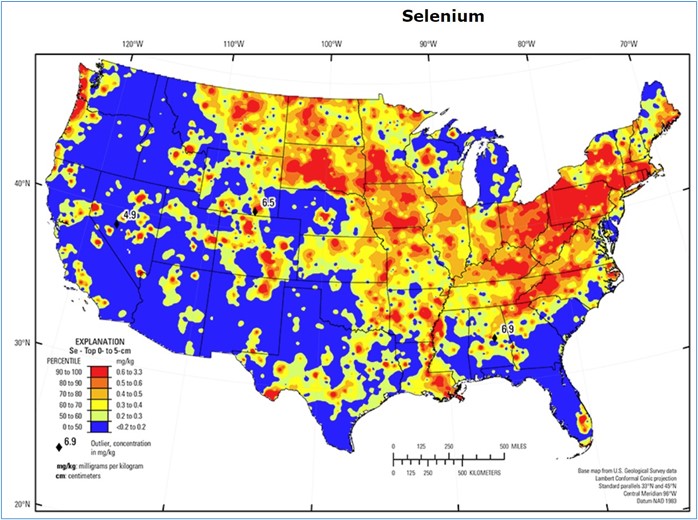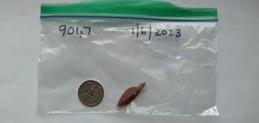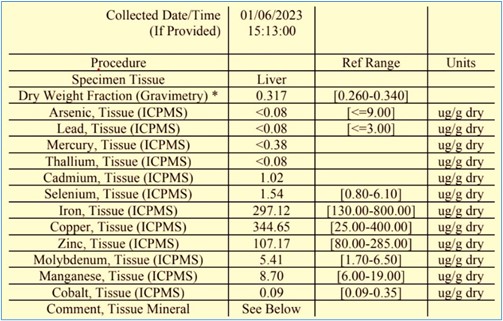We all know that our sheep need minerals, but how do we know that we are not over- or under-supplying their needs? Mineral deficiencies can lead to disease, but too much can lead to toxicity and even death. Minerals interact with each other; high levels of molybdenum can suppress copper levels and cause copper deficiency but it is also used to protect against copper toxicity in instances where high copper levels are present. The whole diet needs to be evaluated, not just the minerals you are offering. Minerals in the soil determine what minerals are available in the forages grown there.
This is the first in a series of articles on minerals. We will look at individual minerals as well as groups of minerals that interact with each other in subsequent articles. Growing animals as well as pregnant and lactating ewes will show clinical signs of mineral imbalances earlier than other classes of sheep. Having the correct balance of minerals available to your flock is important for the general health of your sheep and to ensure optimal production.

Let’s start by looking at this map of selenium in soils across the USA. Farmers in Pennsylvania most likely do not need to add a lot of selenium to their mineral program, however farmers in inland Oregon likely need to supply a selenium rich mineral to prevent deficiencies. Keep in mind that if you live in Pennsylvania and graze during the summer but buy hay from inland Oregon for winter feeding, your flocks’ selenium requirements will be quite different during the two seasons.
The map above is from a survey done by the US Geological Service in 2014. They took soil samples from just under 5000 sites across the USA to produce geochemical and mineralogical maps for soils across the USA. You can see maps for different elements by selecting the element from the table to see the distribution of that element on a map https://pubs.usgs.gov/sir/2017/5118/sir20175118_geo.php
Remember, your farm is unique. Soil pH plays an important role in determining how available minerals in the soil are, and minerals also interact with each other. The particular forages that grow in your pasture will also determine what minerals are available for your animals. The length of a plant’s root determines what depth of soil can be accessed to extract minerals.
Applying soil amendments (lime, chicken manure, etc.) to your pastures and hay fields can have a big impact on the minerals available in the forages and you might have to adjust your mineral program accordingly. There are lime products on the market that contain very high levels of molybdenum that have induced copper deficiency in sheep utilizing these forages after application. There will be more on this in a follow up article about copper and molybdenum.
What is the best way to supply minerals to my sheep?
There are many different ways to supply minerals to your sheep, and each farm has to decide what works best for them as each comes with its own benefits and drawbacks. Some farmers use combinations of different types of minerals to optimize their minerals programs. The form that minerals are supplied as, for example, copper oxide vs copper sulfate, is also important to consider and will be covered in more detail when discussing individual minerals.
Loose minerals
Minerals are provided as loose salt granules. Salt is mined from old sea or lake beds and contains different trace minerals depending on where it comes from. Sodium chloride (NaCL) makes up the bulk of mineral products. Regardless of which specific product you use, loose minerals should be available free choice at all times.
White salt
White in color and lists just sodium chloride (NaCl) on the label, often labeled as “mix and fine” salt, it is usually mixed with a trace mineral premix or offered as part of a mineral buffet. It does not supply any trace minerals.
 Sea salt
Sea salt
Can be white or other colors. This does contain low levels of trace minerals naturally and will list which trace minerals it contains, like the product at right. You might have to add trace minerals in another form to this unless your forages are grown in very well mineralized soil.

Kelp
Dried seaweed that naturally contains trace minerals and vitamins. It will also list on the label which trace minerals it contains, like the product at right. This is a dried plant, so exact mineral content can vary somewhat from batch to batch. Kelp does provide some protein and carbohydrates too.
Mineral mixes
Salt mixed with trace minerals. Many companies have their own nutritionist-developed products. Most companies have slightly different mixes, sold as the same product, formulated for different regions across the USA. Do not stock up on the brand of mineral you use at home if you find it cheaper while on vacation a few states away; check the ingredients and make sure it is the same mix first. Some mixes have other ingredients added as well, in order to increase palatability and therefore consumption. Be sure to check the ingredient labels for these products if you are trying to exclude grain from your flocks’ diets. Some products offer added vitamins, in addition to minerals. Shipping costs can be substantial if you are not able to buy these products locally, as they are heavy.
Mineral premixes
Trace minerals sold in smaller packages that you mix with white salt at home to make a complete mineral mix. If you cannot find pre-mixed minerals locally, this is a good way to save on shipping costs. You can also find specific individual minerals or combinations as well as vitamin premixes that can be very useful to add to other mineral mixes if you have deficiencies in specific minerals.
Loose mineral mixes should have an indication on the label of how much (usually in ounces) an animal should consume per day. Animals that have not had access to minerals for a while will overindulge for a few days, but should taper off to near the recommended consumption level. Measure how much you are putting out and how many animals you have consuming it to see if you are in the ballpark for recommended consumption. If animals continually consume a lot more or less than recommended, you might need to switch to a different product. Keep in mind that sheep often will stop eating minerals when it gets wet. Also, if they have to travel far to get to the mineral feeders, they might decide that it is not worth the effort. You will probably notice that there are certain times of the year when they suddenly eat a lot more minerals. I especially see it during mid to late pregnancy. They might just have a craving for salt, but on the other hand they are eating minerals for two or three or four.
Look at the labels. Trace mineral mixes are formulated and labeled for use in specific species; it will have a list or pictures of which animals it is appropriate for. Added copper is the big reason why all products are not appropriate for all species. It seems like Katahdins require more copper than some other breeds of sheep but there have been instances of copper toxicity in Katahdins too. Keep in mind that if your sheep develop copper toxicity eating a product not labeled for sheep you will not be able to get any reimbursement from the trace mineral company as they do not recommend feeding it to sheep. Trace mineral mixes are formulated by nutritionists for specific species. If your area has specific mineral deficiencies, it might be hard to find a trace mineral salt that perfectly balances out the deficiencies in your area.
Buffet style minerals
Individual minerals are offered in separate boxes and animals get to pick and choose what minerals to consume. I am aware of two companies in the USA that offer minerals in this style. Advanced Biological Concepts https://www.abcplus.biz/Free_Choice_Minerals and Free Choice Enterprises http://www.freechoiceminerals.com/ .
Benefits of loose minerals:
- Widely available in feed stores and online.
- You do not have to dose/inject the animals to give it to them, just offer it and they help themselves.
- Premix style minerals offer a savings on shipping as white salt can be purchased locally.
- If you develop a problem with mineral toxicity or need to change minerals you can stop and just change to another mineral, there is no wash out period.
Drawbacks of loose minerals:
- Need to keep it dry, which can be a challenge on pasture and does require some kind of weatherproof mineral feeder.
- Moving mineral feeders around when rotational grazing adds a little work.
- Wet minerals can leach out some of the minerals and can lead to toxicities if animals drink this brine.
Mineral blocks
Trace minerals can also be purchased in block form. In general, blocks are not recommended for sheep as they do not have big tongues like cows and they might have a hard time consuming enough minerals by licking the block. Some sheep will bite chunks off mineral blocks and this causes undue wear and tear on their teeth, leading to earlier culling of ewes as their teeth are worn down at a younger age.
Some individual minerals are available in block form like cobalt, or sulfur which can be useful to use in addition to other mineral mixes.
Mineral injections and boluses
Individual minerals as well as mineral combinations are available as boluses and injections. These can be used in conjunction with loose mineral mixes to supplement in areas with specific mineral deficiencies. This method of mineral delivery is used much more outside of the USA but some of the imported boluses can be ordered locally.
Benefit of injections/boluses:
- You know animals got the minerals.
- Do not have to lug minerals around.
Drawbacks of injections/boluses:
- If you run into trouble, it is a bolus that is absorbed over time (usually 3-6 months); you cannot remove it once it is in there.
- Not a lot of sheep-specific products available in the US.
How do I know that my sheep are getting enough minerals?
The best way to know is to test the levels of minerals in your sheep. Blood tests as well as tissue levels of minerals are available. Liver testing gives you a better idea of the long-term mineral levels in your sheep vs blood testing. Liver testing is easy and reasonably priced. Michigan State University currently charges $55 for a liver mineral/toxin analysis. I have some examples below where you can see what minerals you can get results for.
Which animals do I sample?
You are trying to get an idea of the mineral levels in your flock so it is best to get a sample from a healthy animal that has had access to minerals up until the time of their demise. It is possible to collect liver samples from live animals via ultrasound guided biopsy, however it is much easier, less expensive, not to mention much less risky to the animal to collect a sample from a deceased animal. Growing, healthy animals that are harvested for food is a great class of animal to sample. Pregnant and lactating ewes that have accidental deaths or lambing mishaps, without prolonged illness (not the ewe that has been sick with ketosis, and not eating for a week, that dies during lambing) will give you a good idea of mineral levels for this class of sheep.
How do I collect a sample?
 All you need is a small piece of liver. You do not have to collect it aseptically, just use the knife you used for slaughter or necropsy and slice off ¼ to ½” thick slice from the edge of the liver, put it in a Ziplock bag, label it with the animal’s ID, and date and freeze it until you have time and inclination to send it in. You can send in fresh liver too but frozen does offer more flexibility. You do need to send in the sample through your veterinarian.
All you need is a small piece of liver. You do not have to collect it aseptically, just use the knife you used for slaughter or necropsy and slice off ¼ to ½” thick slice from the edge of the liver, put it in a Ziplock bag, label it with the animal’s ID, and date and freeze it until you have time and inclination to send it in. You can send in fresh liver too but frozen does offer more flexibility. You do need to send in the sample through your veterinarian.
How often do I need to sample?
If your animals eat the same diet all year round, you can sample any time and should have a good idea of where you stand. If, like me, you feed hay in the winter and graze the rest of the time, I would recommend getting a sample from an animal during each feeding period, so you can compare levels and see if you need to have a different mineral program in different seasons. I do liver samples once a year during winter feeding as we are chronically at the low end of normal for cobalt and selenium in this feeding period and we are still tuning in the ideal mineral program for this time of year.
What do I get back?
 At right is our latest liver test. This sample was collected from a 4-year-old, pregnant, healthy ewe in the middle of pregnancy. You can see that her Selenium levels are in the normal range but at the lower end of the reference range. I would like to be closer to 3 or 4ug/g, as that will put us at the middle of the range, so obviously we need to keep adjusting that. Copper is close to the high end of normal. We used to be at the low end of the reference range and gave copper oxide boluses to our pregnant ewes for two years. We have not done that the last two years as we are close to the upper limit and I worry about copper toxicity in the ewes. Manganese is closer to the low end of normal and Cobalt is right at the bottom of the reference range. We were planning on supplementing the ewes with cobalt boluses this winter, but they arrived late, so I will have to save them for next winter.
At right is our latest liver test. This sample was collected from a 4-year-old, pregnant, healthy ewe in the middle of pregnancy. You can see that her Selenium levels are in the normal range but at the lower end of the reference range. I would like to be closer to 3 or 4ug/g, as that will put us at the middle of the range, so obviously we need to keep adjusting that. Copper is close to the high end of normal. We used to be at the low end of the reference range and gave copper oxide boluses to our pregnant ewes for two years. We have not done that the last two years as we are close to the upper limit and I worry about copper toxicity in the ewes. Manganese is closer to the low end of normal and Cobalt is right at the bottom of the reference range. We were planning on supplementing the ewes with cobalt boluses this winter, but they arrived late, so I will have to save them for next winter.
 This result is from a fellow Katahdin breeder in Pennsylvania. He had a big problem with lambs dying due to severe copper deficiency. This sample is from a 3-week-old lamb. We will discuss this in a lot more detail in the upcoming article about copper and molybdenum. You will see that the reference ranges for this test are different from the other sample above. This test was done at a different lab and each one has their own reference ranges. Unfortunately, this makes it hard to compare samples done at different labs with each other, so if you are re-testing because you changed something, using the same lab can make it easier to interpret the results.
This result is from a fellow Katahdin breeder in Pennsylvania. He had a big problem with lambs dying due to severe copper deficiency. This sample is from a 3-week-old lamb. We will discuss this in a lot more detail in the upcoming article about copper and molybdenum. You will see that the reference ranges for this test are different from the other sample above. This test was done at a different lab and each one has their own reference ranges. Unfortunately, this makes it hard to compare samples done at different labs with each other, so if you are re-testing because you changed something, using the same lab can make it easier to interpret the results.
Remember, if you find something weird, don’t panic, but do check another animal to confirm. I had one sample that I sent in show lead levels above the reference range. The animals were out on pasture at this time, so I tested the flock’s drinking water and did not find lead there, a sample from another animal showed low lead levels and we have not had any animals show high lead levels since. That particular ewe must have ingested something containing lead.
I would definitely recommend doing liver testing if you are giving additional copper so you know where you stand.
Remember, your farm and your animals are unique and soil minerals are vastly different between different areas; you might have to experiment a little to find the ideal mineral program for your flock. Providing all the minerals that your sheep need will go a long way towards ensuring the health and productivity of your flock.
By: Isabel Richards, EAPK Communications Committee
References:
https://pubs.usgs.gov/of/2014/1082/pdf/ofr2014-1082.pdf
https://vdl.msu.edu/Bin/Catalog/Catalog.exe
![]()


